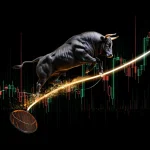
Opening Invocation: A Challenge to Complacency
Jan 30, 2025
What if the very pursuit you thought was mere simulation held the key to a deeper understanding of markets and, by extension, of yourself? Too often, individuals dismiss paper trading as a childish rehearsal—nothing more than a practice run that lacks the “realness” of live transactions. In doing so, they overlook a potent laboratory of learning, one capable of forging discipline and honing strategic clarity before delving into the hazardous front lines of real-world investing. Nowhere is this principle more evident than in TradingView’s paper trading feature, a system that melds technology with direct user experience to create a vibrant testing ground for market ideas. But it is not only about button-clicking or chart-gazing; it is about cultivating a mindset that transcends fleeting trends, employing timeless wisdom to tame the emotional whirlwind of speculation. Prepare to challenge your assumptions, for we shall embark on a journey that fuses philosophy, psychology, and practical skill in an exploration of how TradingView paper trading truly works—and why it may awaken in you a shrewdness that endures well beyond any simulated environment.
The Philosophical Essence of Paper Trading
At its heart, TradingView paper trading is an act of intellectual stewardship. You do not simply throw imaginary pounds at random securities; rather, you navigate a realm of hypothetical risk designed to illuminate your own decision-making processes. This approach can be likened to the discipline of stoics who, throughout history, counselled wise men and women to practise misfortunes in the mind before facing them in reality. Paper trading offers precisely that: you face the possibility of ruin without incurring real financial wounds, witnessing how your psyche reacts to hypothetical gains or losses. This vantage point allows you to craft a more measured outlook, uncluttered by the adrenaline that lives trades can bring.
In many ways, thinking about markets from this philosophical perspective liberates you from an obsession with immediate reward. Instead, you ally yourself with an age-old pursuit of mastery—a mastery that cannot be accomplished solely through textbooks or second-hand advice. It demands personal experimentation with strategies like momentum trading, contrarian reversals, or fundamental investment theses, all within the structured environment that TradingView’s paper trading account provides. In so doing, your perspective expands. You begin to see that the market is not just a place of random surges and collapses, but rather a tapestry of human psychology, capital flows, and cyclical forces that dance in complicated but decipherable patterns. The intangible value is that you confront your illusions—believing perhaps that you can remain calm under fire—only to discover how swiftly euphoria or despair can seize the mind when your trade’s fate wobbles in uncertain territory, even if the capital at risk is merely simulated.
Why Modern Audiences Crave Realism in Simulation
People constantly clamour for authenticity in their endeavours in a world saturated with mindless entertainment. Paper trading may, at first glance, seem inauthentic because real money is not on the line. Yet ironically, it is that very separation from financial risk that frees you to learn faster and more comprehensively. You can intensify your focus on chart patterns, candlestick behaviours, and macroeconomic shifts without fretting over short-term damage to your bank account. By methodically tracking your decisions, you begin to see patterns in your own psychology: do you cut winning trades prematurely out of fear? Do you hold onto losing positions in denial? These patterns would linger in the shadows if you launched directly into live trading.
Furthermore, TradingView caters to a generation that demands on-demand analytics and real-time charting. Anyone who has begun to treat data as an indispensable asset for decision-making will find immediate resonance with the platform’s functionality. The “paper” aspect, in effect, merges seamlessly with TradingView’s visual clarity, study tools, custom indicators, and social networking features. Hence, you adapt to modern technology while simultaneously practising a timeless principle: the rehearsal of potential outcomes so that your psyche and system are ready to face the real version of unpredictability. It is akin to a pilot in a flight simulator, running through engine failures and emergency landings countless times so that when an actual mishap occurs, trained instincts kick in rather than unreasoned panic.
Mechanical vs Emotional: A Dualistic Reality
To proclaim that paper trading wholly mirrors reality would be misleading. Indeed, there is a marked contrast between hypothetical risk and real capital. Once genuine money is on the line, anxieties and overreactions can intensify to an alarming degree. Yet, focusing only on that distinction misses the point. The underlying mechanics—monitoring price movements, setting stop-losses or profit targets, and evaluating fundamental data—remain nearly identical between paper and live scenarios. Where the difference emerges is in the emotional pressure that arises when genuine losses loom. That said, the methodical approach you cultivate in paper trading arms you with a sort of mental scaffolding so that when you do transition to the real stage, your mind is not venturing forth unprepared.
Emotion is powerful within markets, for it can transform an otherwise astute investor into a frantic speculator the moment prices move abruptly. The beauty of paper trading is that it drills routines: you learn to place trades only when certain conditions align, to maintain consistent position sizing, and to remain aware of the discipline demanded by risk management. These routines, when memorised and repeatedly executed, become habits that are less likely to collapse under the weight of real panic. While each trade in a paper environment lacks the sting of actual loss, the repeated process of planning, executing, and reflecting locks in crucial patterns of thought. The ultimate aim: bridging the gap between mechanical proficiency and emotional resilience, so that once real money is at stake, your judgement does not yield to the mania of impulsive decisions.
How TradingView Paper Trading Works in Practical Terms
Concretely, TradingView paper trading sets up a virtual portfolio for you. You have a hypothetical balance to invest, which you can adjust if you wish to simulate large-scale institutional trades or modest small-stake entries. Through TradingView’s interface, you search for the instruments—stocks, forex pairs, cryptocurrencies, or other assets—that pique your interest. You can then select a desired order type, be it market or limit, and specify details such as stop-loss and take-profit levels.
Once the order is placed, TradingView’s system tracks the position as if it were real. You see your hypothetical profit and loss change in real time as the chosen market evolves. At your disposal is a wealth of technical indicators, from relative strength indices to moving averages, that can be overlaid on the dynamic charts. Crucially, you also have the capacity to view your full portfolio breakdown: how much margin you have used in a margin-simulated trade, how your positions are performing day by day, and what your net hypothetical profit stands at. The interface effectively mirrors standard online brokers’ dashboards. This realism fosters a sense of accountability, even though no actual money swings in or out of your bank account.
In parallel, a log of your trading history accumulates, enabling a careful review of each success and failure. By sifting through that log, you see how well you stuck to your trading plan. Did you hold on for too long, ignoring an established exit signal? Did you enter a position prematurely because you felt you could not miss a sudden spike? These behavioural quirks are revealed in black-and-white in the trade history. You glean insights into whether your trades align with your stated strategy or if your impulses hijacked your planning. Over time, you can refine each parameter—your risk tolerance, your methods of scanning for setups, your style of technical or fundamental analysis—until your results begin to match the vision you chase. In short, TradingView’s paper trading is not merely a game; it is a sandbox for forging better version of your investing and trading self.
Blending Timeless Wisdom with Practical Strategies
At this stage, you may wonder which frameworks or strategies you might attempt in the paper environment. Historically, some of the greatest minds in capital markets emphasised patience, discipline, and an unwavering focus on intrinsic value. Others found success in swift momentum plays. In any of these approaches, the central premise stands: practice moderates impulsivity. By systematically testing contrarian plays—perhaps buying when the crowd is fearful—you can examine how accurate your instincts are. Alternatively, you might test exponential breakouts, short-selling peaks, or experimenting with pairs trading on correlated assets. The timeless principle is that you must not blindly adopt someone else’s method without thorough personal trial and reflection.
TradingView’s platform simplifies this exploration through watchlists and alerts. Suppose you are testing a contrarian approach based on a certain indicator that triggers an alert once an asset becomes heavily oversold. Paper trading allows you to pounce on that signal the instant it surfaces, verifying if the bounce that your theory predicts consistently occurs or not. Meanwhile, if you prefer a systematic approach, you can incorporate the platform’s Pine Script, coding small scripts or bots that identify patterns and prompt hypothetical trades. That might sound advanced, but the underlying notion remains to glean universal truths about how markets move under various conditions—truths you can then adapt to live markets with greater composure.
You find a deeper synergy when you integrate these experiments with timeless wisdom from philosophers who preached self-awareness. Your capacity to remain steadfast in a plan depends on an intimate understanding of your own impatience or misguided expectations. The wise of ancient times taught that self-mastery is essential to any worthy endeavour. So in paper trading, aim not just to find profitable setups, but also to tame the unruly sentiments—fear, greed, indecision—that hamper clear thought. In essence, the “game” of simulation morphs into a mirror that reveals your soul’s relationship with risk and reward.
The Psychological Paradoxes of Paper Trading
Yet no exploration of TradingView’s paper trading feature would be complete without addressing potential paradoxes. One subtle issue is that the absence of real risk can breed complacency. Some individuals adopt a flippant approach to paper trading, placing outlandish bets they would never attempt with genuine capital. If that is the path taken, the lessons gleaned could be minimal. A perceived huge profit in a playful scenario might embolden reckless behaviour once you do go live. Similarly, consistently ignoring risk management, such as failing to employ stop-loss orders or allocating 100% leverage, can form bad habits masked by the safety net of simulation. In short, paper trading can be misused if you forget to bring a sense of genuine seriousness to the exercise.
Another paradox arises if you are striving to replicate the stress of real trading but find it difficult because your brain knows the money is fictional. One solution is to impose personal accountability measures. You could, for instance, track your paper results over months and link them to real-world consequences—pledging to donate a certain sum to charity if you fail to honour your rules or meet your paper-trading objectives. Alternatively, you can adopt modest personal punishments each time you break your stated protocol, such as skipping a leisure activity or imposing an extra hour of market study. These contrivances might seem contrived, but they can replicate some sense of risk, which heightens the intensity of your practice runs and helps you form emotional discipline.
In acknowledging these limitations, remember that the ultimate value of paper trading is not to replicate the exact emotional turmoil of real capital at stake. Rather, it is to install the frameworks of consistency, strategic thinking, and systematic execution in your mind. Reducing your impulsive traits is a highly worthwhile pursuit, even if you cannot fully replicate the adrenaline rush that comes from experiencing a heart-stopping drawdown on your real brokerage account.
Common Mistakes and How to Avoid Them
Beginners to TradingView’s simulation often dive in headfirst without a coherent plan. They place random trades, chase every flicker of a potential breakout, or attempt short-term scalp trades with no real method. The remedy is to adopt a structured approach from the start. Write down your goals: Are you testing a long-term investing strategy, trying to refine scalping, or aiming to practise risk management for mid-range swings? Once clear, set rules for entries, exits, and risk tolerance. Doing this gives you a better chance of learning from each trade rather than stumbling blindly. Another frequent oversight is ignoring the outcomes and failing to review what worked or failed. Reflection is key. By meticulously revisiting your trades, you can tease out exactly why a certain approach succeeded or flopped. Was it the market environment, your emotional slip-ups, or a mismatch between your strategy and the instruments you selected?
Moreover, many novices forget to maintain an environment similar to what they will face when going live. For instance, they might pick a hypothetical account size of £1,000,000 while they only intend to trade with a real account of £2,000. The difference in scale can lead to drastically different risk exposures and illusions about how easy or challenging it is to generate certain returns. The same logic applies to ignoring commissions or slippage if you plan to trade frequently. Although TradingView’s paper trading will not necessarily replicate every cost, you can mentally factor in transaction fees or slight price differences to keep your hypothetical environment aligned with realism. Consciously doing so prevents you from being lured into false optimism that might evaporate once real costs hit your smaller, real account.
Bridging the Gap to Live Trading
Eventually, you will sense that your proficiency in the paper environment has earned you the right to test real waters. That transition often provokes a slew of psychological jitters. The challenge becomes integrating your carefully rehearsed routines with newfound emotional intensity. Some individuals discover success on the simulation side, only to flounder amid the real emotional storms that come with actual money. Yet if you governed yourself responsibly in the paper stage—treating each hypothetical trade as if real capital were at stake, reflecting on your mental lapses, and systematically refining your approach—your leap to full authenticity should be smoother. You will have installed in yourself a set of best practices, from position sizing to exit discipline, that can quickly become second nature.
A beneficial technique is to start real trading with smaller than average positions, ensuring that the emotional ramp-up remains manageable. Let each incremental stake reflect the confidence gleaned from your paper results. If your demonstration trading validated a particular method over weeks or months, then replicate that exact method under modest real conditions. Document your mental and emotional states in a journal, noting if you deviate from your rules or feel the urge to. Overcoming that final emotional barrier can be the difference between a frustrated gambler’s approach and the methodical, assured persona you endeavoured to build in your paper sessions.
Harnessing a Holistic Market Perspective
One of the subtler advantages of TradingView paper trading is that it encourages you to observe markets in a panoramic way, not just as random price lines. TradingView’s community fosters discussions on various assets, from niche cryptocurrencies to blue-chip equities. By adopting a paper portfolio, you can dabble in multiple areas—perhaps tracking how geopolitical tensions affect oil trades one day, or how the Federal Reserve’s statements shift forex pairs the next. In so doing, you cultivate a multi-asset awareness that deepens your grasp of how macroeconomic events shape market sentiment. This diversified vantage point becomes especially useful if you eventually decide to spread your real investments across different classes, lessening correlation risks and capitalising on multiple forms of growth. The humility gained from seeing unexpected correlations or witnessing how an unforeseen news story topples your best-laid plans can be immeasurably instructive. Paper trading thus becomes a continuous education, ensuring you do not confine yourself to a narrow, inflexible worldview.
In an era that prizes specialisation, the capacity to see beyond your chosen niche can grant you a powerful edge. TradingView’s paper platform invites precisely that mindset: you are not forced into a single domain, dealing only with, say, penny stocks or major currency pairs. Instead, you can treat your hypothetical account as an evolving puzzle that crosses boundaries, forging an integrated strategy that accounts for monetary policy, cyclical trends, or even basic supply-demand imbalances. The more you practise in this environment, the stronger your instincts become, not just for reading charts, but also for perceiving the underlying stories behind those shifting numbers.
Concluding Wisdom: Embrace, Evolve, Excel
Ultimately, TradingView paper trading operates as a crucible where new and experienced participants alike can refine their craft. In this protected space, the collisions of greed and fear become manageable phenomena to study rather than existential threats to your wallet. Timeless human wisdom—patience, discipline, courage in the face of adversity—merges with modern technology’s capacity to simulate real-time price movements and build robust analytics. The resulting synergy can transform novices into competent, prepared traders who grasp that genuine expertise stems not from guesswork, but from a cycle of trial, reflection, and adjustment. Even for seasoned veterans, revisiting paper trading can reignite clarity, stripping away the baggage of ingrained habits and resetting one’s approach to strategy and risk.
Thus, let this method not be dismissed as mere practice. See it instead as a vital rung on the ladder to trading mastery. Let it expose your weaknesses without bankrupting your future. Let it anchor your best ideas in a framework of consistent execution, and let it remind you of the sobering truth that markets reward the disciplined, not simply the daring. In the final count, your simulated successes and slips will echo in your real trades. When the day comes that actual funds are on the table, the composure, readiness, and adaptability nurtured in paper trading can serve as your shield against the storm of sudden events. Embrace it. Evolve through it. Excel beyond it, and carry forward the lessons gleaned in that environment into the realm of tangible returns, secure in the knowledge that you have rehearsed the moves long before the spotlight of risk was turned upon you.
Let your next step be a bold one: open TradingView, initiate a paper trading account, and treat every moment of simulated trading as a step towards genuine self-discovery. The outcome may not be guaranteed, but the process of forging your discipline and perspective is certain. By challenging your own assumptions and aligning your strategies with the unyielding truths of market mechanics and human psychology, you transform ephemeral simulations into a robust foundation. Therein lies the heart of truly understanding how TradingView paper trading works: not as a game, but as a dynamic rehearsal for the real challenges and victories that lie ahead.












